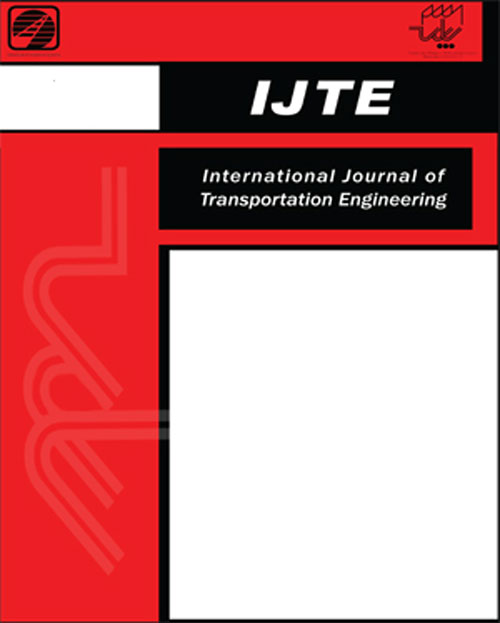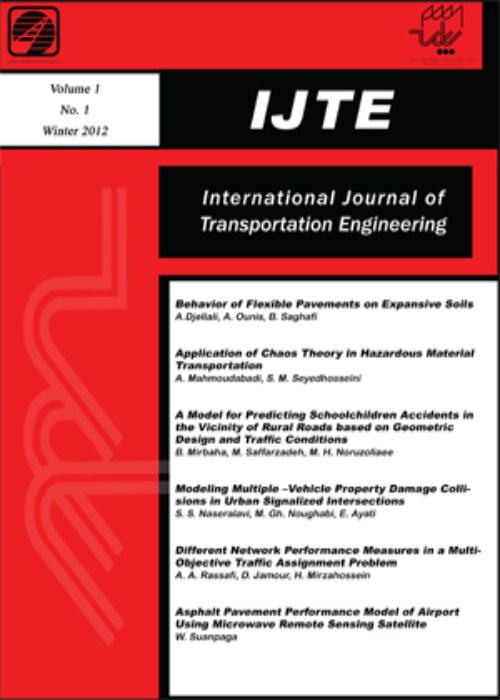فهرست مطالب

International Journal of Transportation Engineering
Volume:2 Issue: 3, Winter 2015
- تاریخ انتشار: 1393/12/25
- تعداد عناوین: 6
-
-
Pages 163-178Road traffic accidents and the effects they subsequently incur are increasing dramatically, and estimating the cost of road traffic crashes could be a vital step in improving the recognition of this widespread problem. The main objective of this paper is to estimate the cost of road traffic crashes in Iran using the Human Capital (HC) Method. Results of this study indicate that the cost of road traffic crashes in Iran for the year 2009 was approximately 114,455 billion Iranian Rials (about $US 11.458 billion), which accounted for 1.41% of Iran’s Gross National Product (GNP) in that year. This study shows that lost output and property damage account for the largest proportion of this cost, whereas human, administration and medical costs are the next highest contributors. In addition, this study estimates the cost of accidents in Iran for the year 2009, depending on their status as fatal, causing serious injury, slight injury and property-damage-only.Keywords: Human Capital Method, crashes, costs, developing countries
-
Pages 179-198Probabilistic approach of traffic assignment has been primarily developed to provide a more realistic and flexible theoretical framework to represent traveler’s route choice behavior in a transportation network. The problem of path overlapping in network modelling has been one of the main issues to be tackled. Due to its flexible covariance structure, probit model can adequately address the problem. Despite that probit is one of the most appealing choice models, due to the lack of closed form expressions for evaluating choice probabilities; it has not received extensive attention by network modeling researchers. This study is set out to focus on this approach of traffic assignment. Computational difficulty of application of probit model in the large-scale network equilibrium problem has triggered development of some link-based probit network loading methods which exempt the analyst from generating and maintaining path-flow variables explicitly. To the best of our knowledge, however, the bias of these heuristic link-based methods has not been studied so far. This contribution primarily focuses on investigation of such potential bias in link-based probit assignment methods. In this research, this bias for a certain simulated link-based method proposed in the literature is empirically considered and investigated through comparison with path-based probit equilibrium solution. Our findings indicate considerable level of bias for the examined link-based algorithm. Capable of representing utility correlation and heteroscedasticity, probit model has always been one of the most theoretically attractive models for representing route choice behavior. However, this soundness of theory could further be enhanced through combining the ideas of probit and random-coefficient modeling which enables the analyst to capture random taste heterogeneity over travelers as well. To do this, the notion of mixed probit model, as a generalization to classical fixed-coefficient probit, is introduced and applied to an illustrative network in this study, in addition to the main contribution of the article.Keywords: Probit Model, multivariate normal distribution, Monte Carlo simulation, random, coefficient choice models, link, based, path, based traffic assignment
-
Pages 199-212Rock slope stability depends very much on the strength features of the rock and the geometrical and strength characteristics of the discontinuities (e.g., roughness, wall strength and persistence). Since a rock mass is not a continuum, its behavior is dominated by such discontinuities as faults, joints and bedding planes. Also, Rock slope instability is a major hazard for human activities and often causes economic losses, property damage (maintenance costs), as well as injuries or fatalities. A computer program has been developed in this research study to perform the stability analysis of a rock slope using the Discrete Element Method (DEM). The rock in the present model is treated as some blocks connected together by elasto-plastic Winkler springs. This method, the formulation of which satisfies all equilibrium and compatibility conditions, considers the progressive failure and is able to find the slip surface or unstable blocks. To demonstrate the applicability and usefulness of the method, several examples have been presented for the analysis and optimization of the rock slope stabilization.Keywords: Rock slope stability, discrete element method, limit equilibrium
-
Pages 213-230In recent research on modelling road collisions very little attention has been paid to rear-end chain reaction collisions, which is characterized by more than two vehicles involved in a collision at the same time. The core aim of the present research is to develop a methodology to estimate such potential collision probabilities based on a proactive perspective, where deceleration rate to avoid collision is used as a surrogate safety measure. In a rear-end chain reaction collision the following driver’s response time and the vehicle’s maximum available deceleration rate are both assumed as stochastic causes of collision. To consider the uncertainty of variables in estimating the N-vehicle rear-end collision, a methodology based on Monte Carlo simulation is proposed. To show the applicability of the proposed methodology, the NGSIM trajectory database of I-80 interstate freeway is used. The probability density function for drivers’ response time is developed through the analysis of 1534 car following situations detected in 45 minutes of movement. The potential risk of two to five vehicle reaction collisions in a five vehicle platoon is estimated by running the simulation through 20 thousand substitutions of randomized generation values drawn from probability density function of response time and maximum available deceleration rate in a following outcome function. Results show that avoiding rear-end collision should be considered as a shared responsibility among the drivers in the platoon. As expected, the methodology considers probability of N vehicles colliding at the same time decreasing as N increases. N-vehicle collision is shown to be directly related to the clearance between the following vehicles within the platoon and the speed of individual vehicles as well as the drivers’ reaction time and the maximum deceleration rate available in individual vehicles. The proposed methodology considers all vehicles in the platoon to estimate the risk of potential chain reaction collisions, rather than just simply focusing only on the two leading and following vehicles. Therefore, the proposed methodology is believed to act more effectively than the ordinary methods, particularly if it is used to alarm drivers of vehicles synchronized based on vehicular ad hoc network (VANET) methodologies.Keywords: Chain reaction rear end collision, response time, maximum available deceleration rate, Monte Carlo simulation
-
Pages 231-243Today, transportation of hazardous materials (i.e., hazmat) is a very important issue for researchers due to the risk of this transit, which should be considered for development of industries and transportation. Therefore, a model that is useful should consider the risk and damage to humanitarian and environmental issues due to transit of hazmat materials. By considering the related cost, the reality and applicability of the model are also very important. In this paper, a bi-objective model is presented for routing rail-truck intermodal terminals with the cost and risk as objective functions by considering three sets of the effective factors that lead to hazardous materials transportation accidents in favor of sustainability. Additionally, a fuzziness concept is considered in the presented model. The model is first validated by the prevalent software using the authoritative solver to solve a numerical example. Furthermore, to help managers, an efficient fuzzy approach proposed in the literature is used. Finally, it is concluded that in this work a reality and sustainable model is suitable for hazmat transportation.Keywords: Rail, truck intermodal, hazmat transportation, sustainable, fuzzy multi, objective method
-
Pages 245-265This study was conducted in order to evaluate the effects of long term ageing on toughness and resilient modulus of asphalt concrete mixtures containing Electric Arc and Basic Oxygen Furnace steel slags. After initial evaluation of the properties of steel slags using X-ray Diffraction and Scanning Electric Microscope, eleven sets of laboratory mixtures were prepared. Each set was treated replacing various portions of limestone coarse aggregates of the mixture (≥ 2.36 mm) with steel slags. The main laboratory program consisted of the determination of resilient modulus at three testing temperatures of 5, 20 and 40˚C (ASTM D4123) and indirect tensile strength of the samples at 20˚C. In order to evaluate the long term performance of mixtures containing slags, the specimens were subjected to ageing according to AASHTO PP2 standard method. Results showed that the peak tensile strength, area up to peak tensile strength and total dissipated energy density of the specimens containing Electric arc furnace slag were greater than the control mixtures. Fracture energy was almost the same for both mixes containing basic oxygen furnace slag and limestone. Results also indicated that the resilient modulus of mixtures increased along with an increase in slag contents in asphalt mixtures. The ratio of aged to unaged resilient modulus of the specimensdecreased upon increasing slag contents. It was concluded that mixtures containing electric arc furnace slag exhibited less susceptibility to ageing compared with mixtures containing basic oxygen furnace slag and limestone. At 5oC, the highest ratio belonged to control mixtures, which might indicate that at lower temperatures, the susceptibility to ageing of the controlmixtures were more pronounced.Keywords: EAF, BOF slag, resilient modulus, IDT, fracture energy, ageing


